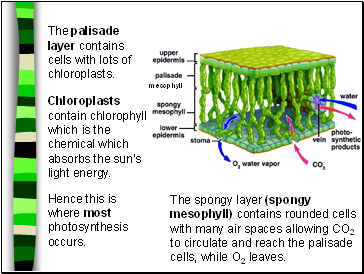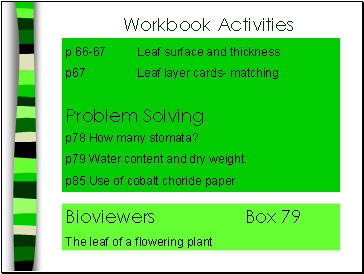MakingFoodPage
3
3
Leave in direct sunlight for a few hours
Result?
A bubble of oxygen gas should form at the top of the test tube as it photosynthesises
Slide 18
Summary of Photosynthesis
Plants’ waste product- oxygen- is essential for animal life.
Slide 19
Quick Quiz 1
1. What does a plant need for photosynthesis?
2. What does a leaf produce during photosynthesis?
3. What is chlorophyll?
4. How do the leaves obtain water?
5. How does the plant obtain carbon dioxide?
6. List 3 uses of the glucose produced by photosynthesis?
7. Name the storage form of carbohydrate in a leaf.
Carbon dioxide, water, chlorophyll, light.
Oxygen, glucose
A green pigment which absorbs the sun’s energy
Through the roots (and xylem tubes by osmosis
From the air (through stomata)
Cellulose (structural), starch (storage), energy
Starch.
Slide 20
A leaf in time Library activity
Source: http://www.life.uiuc.edu/plantbio/102/links.html
Read through the file and take some short notes to summarise the life of a leaf
http://www.portlandpress.com/pp/books/online/leaf/alit_eng.pdf
Slide 21
Leaves…
Leaves are the organs of photosynthesis and make all the food for a plant.
We will look at:
Outer layers (top & bottom)
Inner structure including veins (its transport system)
Slide 22
Internal structure
Collect the handout ‘Leaf structure’ and add labels/notes.
mesophyll
waxy cuticle
Slide 23
Outer layer- upper surface
1. The waxy cuticle is a waterproof layer which cuts down water loss by evaporation.
2. The upper cells of the leaf make up the epidermis.
They are transparent so light passes straight through them into the next layer of cells…
Slide 24
The palisade layer contains cells with lots of chloroplasts.
The spongy layer (spongy mesophyll) contains rounded cells with many air spaces allowing CO2 to circulate and reach the palisade cells, while O2 leaves.
Hence this is where most photosynthesis occurs.
Chloroplasts contain chlorophyll which is the chemical which absorbs the sun’s light energy.
mesophyll
Slide 25
Workbook Activities
p 66-67 Leaf surface and thickness
p67 Leaf layer cards- matching
Contents
- The World of Plants
- Plants- the first link
- Plant survival
- Mans’ uses of plant glucose
- Glucose molecule
- Gas Balance
- Summary of Photosynthesis
- Internal structure
- Outer layer- upper surface
- Outer layer- bottom surface
- Stomata- open
- Stomata- closed
- General structure
- Leaf veins
- Roots
- Into the root hair cell
- Transport in Flowering Plants
- Phloem tissue
- Sugar cane
- Vascular bundles
- Xylem & phloem in stem
- Position of vascular tissue in the stem
- What Limits photosynthesis?
- Factors limiting photosynthesis
- Helping plants to grow
- Signs of Nutrient deficiency in plants
Last added presentations
- Sound
- Practical Applications of Solar Energy
- Simulation at NASA for the Space Radiation Effort
- Thermal Energy
- Newton's laws of motion
- Newton’s Law of Gravity
- Mechanical, Electromagnetic, Electrical, Chemical and Thermal








